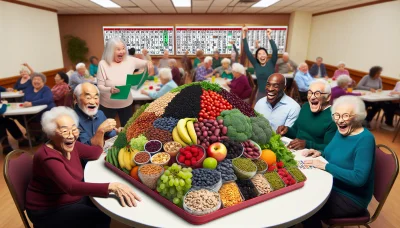High fiber diet example Quiz
Test Your Knowledge
Question of
Understanding High Fiber Diets
Benefits of a High Fiber Diet
Improved Digestive Health
A high fiber diet is a powerhouse for digestive health, promoting regular bowel movements and preventing constipation. It's like a workout for your intestines, keeping things moving smoothly and reducing the risk of digestive discomfort. Moreover, fiber-rich foods feed the beneficial bacteria in your gut, fostering a robust digestive ecosystem that can enhance nutrient absorption and improve overall gut health.
Fiber's role isn't just about speed; it adds bulk to your stool, which can help prevent both constipation and diarrhea. Imagine it as a regulator for your digestive tract, maintaining just the right pace and consistency. This balance is crucial for avoiding common gastrointestinal issues that can disrupt daily life.
Reduced Risk of Chronic Diseases
Embrace the protective shield that fiber offers against some serious health adversaries! A diet rich in fiber has been linked to a lower risk of heart disease by helping to reduce blood pressure and cholesterol levels. It's like having an internal bodyguard working around the clock to keep your heart healthy.
Beyond heart health, fiber shows its might by playing a role in reducing the risk of type 2 diabetes and certain types of cancer. The magic happens as fiber helps regulate blood sugar levels and promotes a feeling of fullness, which can lead to healthier eating patterns and weight management key factors in preventing chronic diseases.
Types of Dietary Fiber
Soluble Fiber Sources
Soluble fiber is the superhero of blood sugar control and cholesterol management. Found in oats, legumes, apples, and carrots, it dissolves in water to form a gel-like substance. This process slows down digestion, allowing for gradual sugar absorption and providing you with steady energy while keeping hunger pangs at bay.
Ingesting soluble fiber is like sending in a cleanup crew for your arteries; it helps to lower LDL (bad) cholesterol levels, thus protecting your heart from disease. It's an easy win for your health simply incorporating these foods into your diet can have profound benefits!
Insoluble Fiber Sources
The roughage found in whole grains, nuts, potatoes, and green leafy vegetables is known as insoluble fiber. This type doesn't dissolve in water; instead, it adds bulk to waste in the digestive system think of it as the broom that sweeps through your intestines, keeping everything moving along swiftly.
- Whole Wheat: Choose bread and pasta labeled "whole wheat" or "whole grain" for a straightforward swap from their refined counterparts.
- Nuts & Seeds: A handful of almonds or sunflower seeds can be an easy snack or salad topping packed with insoluble fiber.
- Veggies: Don't peel those skins! The skins of potatoes and other vegetables are rich in insoluble fiber.
- Fruit Skins: Similarly, apple skins contain valuable fiber that's lost if you peel them away.
- Bran: Bran cereals or muffins are tasty ways to incorporate more insoluble fiber into breakfasts or snacks.
Planning Your High Fiber Diet
Daily Fiber Intake Recommendations
Embarking on a high fiber diet? Let's kick things off with some sizzling facts! First, it's vital to know how much fiber you should aim for each day. For adults, the magic number ranges from 25 to 38 grams. However, the average person is only hitting about 15 grams daily. That's way below the recommended intake! Boosting your fiber intake can work wonders for your digestive health and overall well-being.
Bear in mind that these are not just arbitrary numbers; they're backed by science to help reduce the risk of chronic diseases. High fiber foods include fruits, vegetables, legumes, and whole grains. By making these foods the stars of your plate, you're on the right track to meeting those fiber goals. So pump up that fiber intake and watch as your body thanks you with vitality and vigor!
Guidelines for Men and Women
Alright folks, here's the lowdown on gender-specific fiber needs: men under 50 should aim for a robust 38 grams per day, while women should target 25 grams. As we age, our bodies require less fiber; men over 50 need about 30 grams, while women need 21 grams. These guidelines are not just numbers; they are your ticket to a healthier life!
Its crucial to understand that these recommendations are tailored to ensure optimal health benefits based on physiological differences between men and women. Adhering to these guidelines can significantly improve digestion and prevent various health issues. Remember, guys and gals, personalizing your fiber intake is key to a thriving body!
Adjusting Fiber Intake with Age
As we age like fine wine, our digestive system changes too. It becomes essential to adjust our fiber intake accordingly. For seniors, a slightly lower intake is recommended because of decreased physical activity and metabolic rate. But don't be fooled fiber is still a senior superstar for maintaining bowel health and preventing constipation.
It's worth noting that as our bodies change over time, fiber continues playing its protective role against diseases such as colon cancer and heart disease. So make sure you keep that fiber coming even as you embrace those golden years! A gradual shift in dietary habits can help maintain balance without shocking the system.
Creating a Balanced Meal Plan
When planning a high-fiber diet, variety is your best friend! Aim for an array of fruits, veggies, whole grains, nuts, seeds, and legumes across meals. This colorful assortment doesn't just make for Instagram-worthy plates; it ensures you're getting both soluble and insoluble fibers which work together for digestive bliss.
To truly champion a high-fiber diet, integrate these power-packed nutrients into every meal like a pro chef. Start with oatmeal or whole grain toast at breakfast; toss beans into your lunch salad; opt for brown rice or quinoa at dinner. And remember: water is your ally when increasing fiber stay hydrated!
Incorporating Fiber at Every Meal
- Breakfast: Kickstart your day with oats or bran cereals paired with berries or banana slices.
- Lunch: Choose whole-grain breads for sandwiches or mix chickpeas into salads for an extra punch of fiber.
- Dinner: Get creative with lentil stews or stir-fried veggies alongside brown rice or barley.
- Tips:
- Sneak veggies into omelets or smoothies at breakfast.
- Add chia seeds or flaxseeds to yogurts or salads.
- Ditch refined pasta; go for whole-grain versions instead.
- Munch on air-popped popcorn instead of chips for a high-fiber snack.
Snacks for Sustained Energy
Fiber-filled snacks are not just tasty; they're energy powerhouses that keep you feeling full longer! Think fresh fruit with nut butter or veggie sticks dipped in hummus. These snacks pack a punch of nutrients while helping curb those pesky mid-day hunger pangs.
Dedicate yourself to snacking smarter! Swap out those low-fiber temptations with almonds, pear slices or even dark chocolate-covered strawberries (in moderation). Your body will relish the sustained energy boost without the crash often associated with processed snacks. Keep it high-fiber for peak snack satisfaction!
High Fiber Foods to Include in Your Diet
Fruits and Vegetables High in Fiber
Integrating fiber-rich fruits and vegetables into your diet is a game-changer for digestive health and overall well-being. These natural powerhouses not only provide essential vitamins and minerals but also an abundance of dietary fiber that aids in maintaining a healthy gut. A diet rich in fruits and vegetables can contribute to weight management, reduced risk of heart disease, and improved bowel movements.
When selecting fruits, it's important to focus on variety to maximize the fiber benefits. Each fruit offers a unique profile of nutrients and fiber content, making it crucial to incorporate a range of choices into your diet. Regular consumption of these fibrous foods can lead to long-term health improvements, including better blood sugar control and a strengthened immune system.
Berries, Pears, and Leafy Greens
Berries are not just delicious; they're also incredibly high in fiber and antioxidants. A bowl of mixed berries, such as raspberries, strawberries, or blackberries, makes for a refreshing snack that packs a fibrous punch. Pears, with their skin on, are another high-fiber choice that can easily be integrated into your daily diet.
Don't overlook leafy greens! Spinach, kale, and Swiss chard are loaded with fiber while being low in calories. These versatile vegetables can be enjoyed raw in salads or cooked as part of numerous dishes, contributing significantly to your daily fiber intake.
Root Vegetables and Apples
Root vegetables like carrots, beets, and sweet potatoes are not only flavorful but also brimming with dietary fiber. Their high nutrient content supports various bodily functions while helping you feel full longer. Including these vegetables in your meals is an excellent way to ensure a balanced intake of both soluble and insoluble fibers.
Apples are a convenient and tasty source of fiber that can be enjoyed on the go. With a variety of types available year-round, apples offer versatility in flavor while contributing to your daily fiber goals. Remember to eat the skin for maximum fiber benefits!
Whole Grains, Nuts, and Seeds
Whole grains should be a staple in any high-fiber diet plan. They're not just filling; they also play an essential role in reducing the risk of chronic diseases such as type-2 diabetes and heart disease. Swapping out refined grains for whole-grain alternatives is an easy way to boost your fiber intake without compromising on taste.
Quinoa, Oats, and Brown Rice
Quinoa isn't just trendy; it's a nutrition powerhouse offering both protein and fiber. Oats are another excellent choice for breakfast or snacks since they contain beta-glucana type of soluble fiber known for its cholesterol-lowering effects. Brown rice serves as an ideal base for various dishes while enriching your meal with its natural fibrous content.
Almonds, Chia Seeds, and Flaxseeds
- * Nuts like almonds are not only satisfying but also packed with both fiber and healthy fatskey components for cardiovascular health. * Chia seeds are tiny yet mighty sources of fiber that can absorb several times their weight in water, thus aiding hydration and prolonging fullness. * Flaxseeds blend seamlessly into smoothies or yogurts while providing a significant amount of both soluble and insoluble fibers. * Opting for whole nuts over sliced or slivered versions ensures maximum nutrient retention during digestion. * Introduce seeds gradually into your diet to allow your digestive system to adjust to their high-fiber content. * Always drink plenty of water when increasing your intake of nuts and seeds to help the body process the additional fiber efficiently.
Sample High Fiber Meal Ideas
Breakfast Options to Start Your Day
Kick off your morning with a nutrient-packed breakfast that sets the tone for the day! A high fiber breakfast aids digestion and keeps you feeling full longer. Trust me, your body will thank you for this energizing start!
Dive into the world of high-fiber cereals and oatmeals; they're not just good for you, they're delicious too! With a variety of textures and flavors, you can customize your bowl to suit your taste buds while fueling up on essential nutrients.
High Fiber Cereals and Oatmeals
Choosing high fiber cereals or oatmeal for breakfast can be a game-changer. These options are often loaded with whole grains that provide sustained energy. Look for cereals with at least 5 grams of fiber per serving for maximum benefits.
Oatmeal is a versatile superstar in the high-fiber lineup. It's a blank canvas ready to be adorned with nuts, seeds, and fruits, boosting both its flavor profile and fiber content. A warm bowl of oatmeal is not just comforting; it's a fiber powerhouse!
Smoothies with Fibrous Add-ins
Smoothies are a fantastic way to pack in your daily fiber. By blending in fruits like berries, apples, or bananas, along with veggies like spinach or kale, you create a fiber-rich drink that's absolutely bursting with vitamins and minerals!
Don't forget those fibrous add-ins! Chia seeds, flaxseeds, or even a scoop of nut butter can elevate your smoothie from simple to sensational. Not only do they thicken it up nicely, but they also add an invaluable punch of dietary fiber.
Lunch and Dinner Recipes
When lunchtime rolls around, keep the momentum going with meals rich in fiber. It's easier than you think to incorporate more of this digestive-friendly nutrient into your midday meal. And come dinner time? A high-fiber dish can round out the day perfectly!
Creative salads and hearty soups make meeting daily fiber goals not just doable but utterly delightful. With endless combinations at your fingertips, these dishes can be as varied as they are nutritious perfect for keeping both taste buds and body happy.
Salads Rich in Fiber
A salad isn't just lettuce; it's an opportunity! Load it up with beans, nuts, seeds, and a rainbow of vegetables to transform it into a fiber feast. Each bite offers different textures and flavors alongside that crucial nutrient: fiber.
- Mix leafy greens like spinach or kale with colorful peppers, carrots, and tomatoes.
- Add protein-rich chickpeas or black beans for an extra boost of fiber.
- Sprinkle on some almonds or sunflower seeds for crunch and additional nutrients.
- Dress it up with olive oil-based dressing for healthy fats that enhance absorption of vitamins!
Hearty Soups and Stews
Soups and stews aren't just soul-warming; they're also perfect vessels for fiber. Legumes like lentils or kidney beans add heft and heartiness along with their fibrous benefits making these dishes both satisfying and health-smart.
Incorporate a variety of vegetables like squash, broccoli, and potatoes into your soups or stews. The diversity of ingredients not only contributes different fibers but also ensures you get a wide range of vitamins and minerals in one go!
Managing a High Fiber Diet Transition
Gradually Increasing Fiber Intake
Embarking on a high fiber diet is a thrilling journey towards amazing health benefits! To avoid overwhelming your digestive system, start with small increments. Add an extra serving of fiber-rich foods like fruits, vegetables, or whole grains every few days to ease into the change.
Remember, it's not just about quantity; it's also about variety. Incorporate different types of fibersoluble and insolubleto reap the full spectrum of benefits. This method ensures a smoother transition and allows your body to adjust without distress.
Avoiding Digestive Discomfort
Diving too quickly into a high fiber diet can lead to bloating and gasdon't let this discourage you! Listen to your body and adjust your fiber intake if discomfort arises. Cooking your veggies can help make them gentler on the stomach for those more sensitive.
- Avoid consuming large amounts of fiber all at once.
- Be mindful of high-fiber foods that may cause more gas, such as beans and lentils.
- Consider a digestive enzyme supplement to aid in breaking down fiber-rich foods.
- Maintain a balanced diet to ensure proper nutrient intake while increasing fiber.
- Monitor how different fiber sources affect you individually and adjust accordingly.
Tracking Your Progress
Keeping a food diary can be incredibly empowering! It helps you stay committed to your goals and provides insight into your dietary patterns. Note the types and amounts of fibrous foods you consume and any changes in digestion or well-being.
Achieving your fiber goals doesn't happen overnightit's a gradual climb. Celebrate the small victories along the way, such as increased regularity or less bloating, as these are signs that your efforts are paying off!
Hydration and Fiber Consumption
Fiber and water are partners in crimethey work together to keep things moving smoothly in your digestive tract. As you increase your fiber intake, aim to drink more water throughout the day to facilitate the passage of fiber through your system.
Importance of Water Intake
The role of water in a high-fiber diet cannot be overstatedit's absolutely vital! Water helps dissolve soluble fiber, creating a gel-like substance that aids digestion. Insoluble fiber relies on water to add bulk and soften stool, preventing constipation.
Signs of Adequate Hydration
Your body will thank you for proper hydration with clear or light yellow urinea telltale sign that you're on the right track. Other positive indicators include regular bowel movements and absence of thirst. If these signs are present, pat yourself on the back for nailing your hydration needs!
Overcoming Challenges with High Fiber Diets
Dealing with Common Side Effects
Embarking on a high fiber diet can lead to transformative health benefits, but it's not uncommon to experience some side effects. The increase in dietary fiber, especially if done abruptly, can lead to bloating and discomfort. It's critical to understand that these reactions are temporary as your body adjusts to the new diet.
To mitigate these initial side effects, it's imperative to increase your water intake. Water helps fiber pass through the digestive system more smoothly, reducing the risk of constipation and bloating. Make sure you're sipping consistently throughout the day hydration is your best ally here!
Bloating and Gas Management
Bloating and gas are often the most talked-about concerns when increasing fiber intake. Tackling these issues head-on involves a gradual increase in fiber-rich foods, allowing your digestive system to adapt at a comfortable pace. Listen to your body and scale up slowly it knows what it can handle!
Moreover, physical activity can significantly aid in reducing gas and bloating. Engage in regular exercise to stimulate digestion and keep things moving along your gastrointestinal tract. This proactive approach can greatly enhance comfort during this dietary transition.
Adjusting Fiber Types and Amounts
Fiber comes in two main types: soluble and insoluble. Each plays a distinct role in digestion. Soluble fiber dissolves in water and can help lower glucose levels, while insoluble fiber does not dissolve, aiding in moving food through your digestive system. Balancing both types is crucial for optimal health.
- Soluble Fiber: Found in oats, beans, lentils, and some fruits.
- Insoluble Fiber: Located in whole grains, wheat bran, nuts, and vegetables.
- Moderation is Key: Start with smaller amounts of fiber and gradually increase over time.
- Diversity: Include a variety of fiber sources in your diet for a balanced intake.
- Listen to Your Body: Pay attention to how different foods affect you and adjust accordingly.
Dining Out and Staying on Track
Dining outside doesn't have to derail your high-fiber regimen. With strategic planning and smart choices, you can enjoy eating out without compromising on your dietary goals. Familiarize yourself with menu items that are likely to align with your nutritional needs before arriving at the restaurant.
An essential tip is to look for dishes rich in vegetables, whole grains, or legumes these are naturally high-fiber options. Salads are often a safe bet but watch out for high-calorie dressings that may be counterproductive. Opt for dressing on the side to maintain control over your intake.
Making Smart Menu Choices
Eating out doesn't mean you have to forego enjoyment for health. Many restaurants offer delicious dishes packed with fiber if you know where to look. Grilled vegetable platters, bean-based soups, or quinoa salads can be both satisfying and aligned with your dietary objectives.
Avoid being swayed by low-fiber temptations by deciding what you'll order ahead of time. Stick to your plan once at the restaurant, ensuring that you stay true to your high-fiber goals while still relishing the dining experience.
Communicating Dietary Needs
When eating out, don't hesitate to communicate your dietary preferences or restrictions clearly with the staff they're there to help! A straightforward request for meal modifications like extra veggies or swapping out refined grains for whole ones can make all the difference.
Inquire about ingredients if you're unsure about a dish's fiber content. Chefs often accommodate dietary requests by altering recipes or suggesting suitable alternatives that will keep you on track without sacrificing flavor or dining pleasure.












